The battle
2nd Free French armored division
Organisation
- Task Force "Dio" (G.T.D)
Reconnaissance: 4e R.M.S.M
Armor: 12e Cuirassiers
Tank destroyers: 3e R.B.F.M
Infantry: 1er régiment de Marche du Tchad
Artillery: 1/3e R.A.C.
Engineers: 2/13e bataillon du génie - Task Force "Langlade" (G.T.L)
Reconnaissance: 2e R.M.S.M
Armor: 12e Régiment de Chasseurs d'Afrique
Tank destroyers: 4e R.B.F.M
Infantry: 2e régiment de Marche du Tchad
Artillery: 1/40e R.A.N.A
Engineers: 2/13e bataillon du génie - Task Force Warabiot (G.T.V)
Reconnaissance: 3e R.M.S.M
Armor: 501e regiment de Chars de Combat
Tank destroyers: 2e R.B.F.M
Infanterie: 3e régiment de Marche du Tchad
Artillery: 11/64e R.A
Enginners: 2/13e bataillon du génie
History
Origins
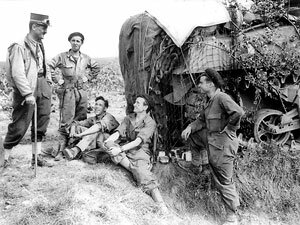 August 1944 - Leclerc with its men of 501e RCC (Basse-Normandie/
August 1944 - Leclerc with its men of 501e RCC (Basse-Normandie/
NARA)
The history of the 2nd Free French Armored Division is closely related to the history of General Leclerc, its founder. Leclerc, POW after the disastrous campaign of France, managed to escape from his Oflag and joined General of Gaulle in London end of June, 1940. It was then entrusted with the mission to convice the African colonies of France (AEF / AOF) to join the Free France. He rallied Cameroun as on August 27th, then Gabon on November 10th. The rally of the AEF / AOF allowed Leclerc to hold a huge manpower reserve and a place to continue the war on the sides of the Allies.
Quickly, Leclerc launched the troops of the African army in a series of raids through the desert. For the first of them, starting from Chad with 400 men, he crossed 1500 kilometers and seized the Italian oasis of Koufra, in Libya. It is in Koufra that, on March 1st, 1941, Leclerc lent oath “to deposit the weapons only when our colors would float on the cathedral of Strasbourg”.
This policy of raids was continued between 1941 and 1942, Leclerc carrying out successfully a series of operations against the Italian oases of the Fezzan region (south-western of Libya). These successes granted him promotion to the rank of brigadier. On January 26rd, 1943, the still modest forces of Leclerc joined Montgomery's 8th Army to take part to the campaign of Tunisia. The Leclerc column took the name of “Force L”, quickly renamed the 2nd Free French Division, as it get strenghtened by the 1st company of tanks and the 1st regiment of Maroccan Spahis. It and in this order of battle that it entered Tunis in May 1943.
From the Leclerc column to the 2nd Free French armored division
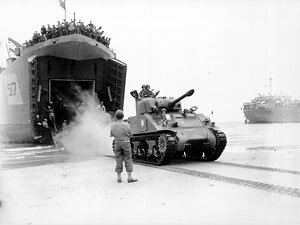 August 1st, 1944 - Unloading of 2nd Free French armored division.
August 1st, 1944 - Unloading of 2nd Free French armored division.
During the summer of 1943, Leclerc received mission from De Gaulle to turn his armored column which counted at that time no more than 4.000 men into the 2nd Free French armored Division, which was to be organized and supplied on the model of American units. On August 24th, 1943, the 2nd DFL officially became the 2nd armoured division (2e DB). In September, the newborn 2nd Free French armored division was gathered in Temara, in Morocco, to take profit from the proximity of the American equipment and training yards. It spent this time to complete its preparation and to complete its manpower until April 1944.
It is in Temara that the 2e DB took the shape of a full value armored unit. Leclerc succeeded in finding 12.000 additional men by integrating not only individual volunteers, but also complete units (obeying until November 1942 to the collaborationist government of Vichy). An interesting aspect was that the division comprised some female soldiers in the 13th medical battalion.
Naturally, De Gaulle wished the division to take part to the invasion of Normandy. Hence, gradually, the men and the equipment started to leave Morocco for England from April 1944. The 2nd Free French armored division was attached to the 3rd US Army of Gen. Patton. After some additional training in Yorkshire, the 2e DB received the long awaited order to land, on August 1st, on Utah Beach.
In Normandy
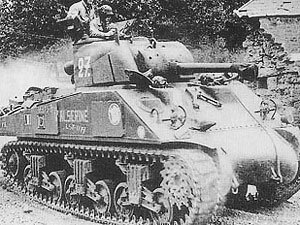 August 1944 – A M4A2 Sherman of the 2e DB during the raid from
August 1944 – A M4A2 Sherman of the 2e DB during the raid from
Le Mans to Alençon
The 2e DB received a double mission, military and political. From a strictly military point of view, it had to fight along with the 3rd Army of Patton to exploit the breach opened in Avranches. The political aspect of its mission was to run on Paris to avoid the American AMGOT (American Governement for Occupied Territories) or the French Communists to seize power.
After assembling near La Haye-du-Puits, the 2nd dB was immediately attached to the 15th Corps (with 5th armored and 79th infantry divisions). It took profit of the Avranches corridor to drive south-east, on Vitré, Chateau-Gonthier, then Le Mans, reached on August 9th. From Le Mans, the 15th Corps turned north, aiming on Alençon.
On the left flank of the 5th US armored division, Leclerc’s division liberated Alençon on August 12th, then Ecouché the next day. Soon, it encountered AT ambushes positioned by 9. PzD freshly recalled from Nimes. After violent fighting in the Ecouves forest, French successfully overcame enemy resistance and could advance north, on Argentan. However, their units dispersed on the small roads leading to the town, creating inextricable traffic jams with 5th US armored division. Reconnaissance units of the French division entered Alençon in the night of August 13th, but they were promptly driven back by German forces, firmly holding the town.
The allied High Command wished to have the 2nd Free French armored division to take part in the closing of the Falaise pocket, by reaching the Poles coming from north. Hence, 2nd Free French armored division advanced northeast, on Oméel. August 19th, it directed some patrols of task force “Massu” on the southern slopes of hill 262, but failed to operate the junction with the polish armoured division.
Obviously, the attention of gen. Leclerc was now focused on Paris, which population started an upraising on August 18th. On August 21st, covered by Gaulle but without the formal authorization of Eisenhower, Leclerc ordered de Guillebon to drive on Rambouillet, with the aim to reach Paris as soon as possible.
The fighting in Normandy claimed heavy losses for the 2e DB. It deplored 133 killed, 648 wounded and 85 missing.
Liberation of Paris
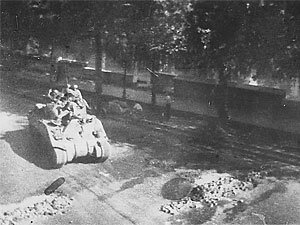 A Sherman of the 2nd Free French armored division in Paris The strike of the police force in Paris had given the signal to the general insurrection. After a few days of fighting in the capital, and because of the deliquescence of the front in Normandy, the German troops had started to evacuate the French capital but still occupied important positions. August 23rd, Leclerc division resumed its advance east and progressed in two parallel columns: the tactical groups Langlade and Dio by Mortagne, Maintenon, Rambouillet, Saint-Cyr, and the Billotte group by Carrouges, Mamers, Chartres, Orsay; the same evening, Leclerc was in Rambouillet.
A Sherman of the 2nd Free French armored division in Paris The strike of the police force in Paris had given the signal to the general insurrection. After a few days of fighting in the capital, and because of the deliquescence of the front in Normandy, the German troops had started to evacuate the French capital but still occupied important positions. August 23rd, Leclerc division resumed its advance east and progressed in two parallel columns: the tactical groups Langlade and Dio by Mortagne, Maintenon, Rambouillet, Saint-Cyr, and the Billotte group by Carrouges, Mamers, Chartres, Orsay; the same evening, Leclerc was in Rambouillet.
The advance continued the next day, this time meeting stronger german resistance. Arrived to Croix-de-Berny, Leclerc ordered to captain Dronne “to immediately take direction on Paris”. Around 9 PM, the three tanks of its platoon, Champaubert, Montmirail, and Romilly, penetrated in the capital and reached shortly after the Town hall, while all the bells of the capital sounded to celebrate the arrival of the first detachment of the division.
On Friday August 25th, the Billotte group moved on the prefecture. On the way, the Kommandantur, located close to the Opera, was taken, and Leclerc could receive the surrendering of gen. von Choltitz, commander of the so-called “Gross Paris”. At 4 PM, De Gaulle met Leclerc at the Montparnasse station, before delivering his speech at the Town hall. After having taken part in the victory procession on the Champs-Élysées, on August 26th, a group of the 2nd armoured division had to repulse a German counter-attack launched on Le Bourget, Stains, and Pierrefitte. The failure of this counter-offensive allowed the French to definitively drive out the German troops from the northern suburbs.
In Eastern France
Once having liberated Paris, the “2e DB” was sent towards Strasbourg. Leclerc aimed on the Vosges and Alsace, with Epinal as objective. Its drive was punctuated with several victories: liberation of Vittel (September 12th), destruction of the 112th German armoured brigade in Dompaire (September 13th), crossing of the Moselle (September 21st). Then it was the push towards the east, which started with the capture of Badonviller on November 17th. After having crossed the Vosges in three days by small roads to circumvent the enemy, the 2nd armored division liberated Saverne on November 22nd, thus opening the road of Strasbourg.
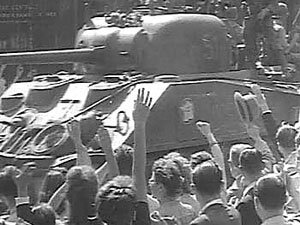 Liberation of Paris Leclerc, wisely avoiding to inform his American superiors, ordered to attack at all costs, by circumventing all pockets of resistance likely to cause delays: his objective was to enter the city as quickly as possible. Five columns of armoured tanks started their drive on November 23rd towards the Alsatian capital. In spite of the resistance of several forts surrounding the city, the squadron of colonel Rouvillois succeeded in penetrating in Strasbourg. Leclerc settled at 2 PM in the Rhine Palace, fled a few hours sooner by Nazis leaders who had ruled the Alsatian capital during more than four years. The oath of Koufra was kept!
Liberation of Paris Leclerc, wisely avoiding to inform his American superiors, ordered to attack at all costs, by circumventing all pockets of resistance likely to cause delays: his objective was to enter the city as quickly as possible. Five columns of armoured tanks started their drive on November 23rd towards the Alsatian capital. In spite of the resistance of several forts surrounding the city, the squadron of colonel Rouvillois succeeded in penetrating in Strasbourg. Leclerc settled at 2 PM in the Rhine Palace, fled a few hours sooner by Nazis leaders who had ruled the Alsatian capital during more than four years. The oath of Koufra was kept!
Last fights
The capture of Strasbourg marked the end of the 1944 campaign. Being short on reinforcements and supply, Leclerc could not cross the Rhine. It would be necessary to await end of January 1945 to see the 2nd armoured division integrated into the 1st French Army and deployed against the pocket of Colmar - this latter will be reduced on February 3rd.
In charge of reducing the pocket of Royan, a remnant of the Atlantic wall, in April 1945, the Leclerc division was transported in Germany no sooner than beginning of May, 1945. It was attached to the 7th US Army, which advanced in Bavaria. The last combat of the French division was the capture of Berchtesgaden, the private residence of Hitler, on May 8th, 1945.













 www.evl.pl
www.evl.pl